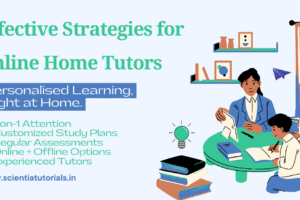Tips for Home Tutors on Tailoring Lessons for Special Educational Needs
Introduction
In today’s diverse educational landscape, home tutors play a pivotal role in supporting students with special educational needs (SEN). Each student has unique learning requirements that must be addressed to help them achieve their full potential. Tailoring lessons for these students is not just beneficial; it’s essential. This article provides home tutors with practical strategies and insights to customize their teaching methods, ensuring that every student receives the support they need to thrive academically and personally.
Understanding Special Educational Needs
Defining Special Educational Needs
Special educational needs refer to a variety of conditions that may hinder a student’s ability to learn in a traditional classroom environment. These needs can arise from physical disabilities, learning disabilities, emotional disturbances, or developmental delays. Understanding the specific challenges that each student faces is the first step in tailoring effective lessons.
The Importance of Individualized Learning
Every student learns differently, and those with special educational needs often require personalized approaches to grasp concepts effectively. Individualized instruction helps bridge learning gaps, builds confidence, and fosters a love for learning. By recognizing each student’s unique strengths and challenges, tutors can develop strategies that empower them to succeed.
Creating a Supportive Learning Environment
Establishing Trust and Rapport
Building a strong relationship with students is crucial for effective learning. Take time to understand their interests, preferences, and fears. Create an open and supportive atmosphere where students feel comfortable expressing themselves and asking questions. This trust fosters a sense of safety, making it easier for students to engage with challenging material.
Organizing the Learning Space
A well-organized and distraction-free learning environment can significantly enhance a student’s focus and motivation. Ensure that the learning space is equipped with necessary materials and resources tailored to the student’s needs. Use visual aids, tactile materials, and assistive technology as appropriate to support various learning styles.
Setting Clear Expectations
Clearly communicate learning objectives and expectations at the beginning of each session. Students with special educational needs often thrive with structure and routine. Outline what they will be working on, the goals for the lesson, and how they can achieve those goals. This clarity can reduce anxiety and enhance focus.
Adapting Lesson Plans
Assessing Individual Learning Styles
Each student has a preferred learning style, whether visual, auditory, kinesthetic, or a combination of these. Begin by assessing how your student learns best and adapt your teaching methods accordingly. For instance, visual learners may benefit from diagrams and charts, while kinesthetic learners might require hands-on activities to grasp concepts effectively.
Differentiating Instruction
Differentiated instruction involves tailoring lessons to accommodate various learning styles, interests, and abilities. Use a range of teaching methods and materials, such as group activities, one-on-one instruction, and multimedia resources, to meet the diverse needs of your students. This approach can help ensure that every student is engaged and progressing at their own pace.
Creating Modified Assignments
Modify assignments to suit the individual needs of students. This could mean simplifying instructions, breaking tasks into smaller steps, or providing additional time to complete assignments. Make sure the assignments remain challenging but achievable, promoting a sense of accomplishment without causing frustration.
Utilizing Assistive Technology
Exploring Available Tools
Assistive technology can provide significant support for students with special educational needs. Tools such as text-to-speech software, speech recognition programs, and interactive learning apps can help make learning more accessible. Familiarize yourself with the tools available and incorporate them into your lessons where appropriate.
Personalizing Learning with Technology
Using technology can enhance engagement and cater to different learning styles. For example, visual learners may benefit from educational videos, while auditory learners might find podcasts or audiobooks helpful. Explore various applications and programs that can be tailored to your student’s interests and needs, making learning more enjoyable and effective.
Implementing Effective Communication Strategies
Encouraging Open Dialogue
Effective communication is key when working with students with special educational needs. Encourage open dialogue during lessons, allowing students to share their thoughts, questions, and feelings. Use positive reinforcement and active listening techniques to create a supportive atmosphere where students feel valued and understood.
Using Clear and Simple Language
When explaining concepts, use clear, concise language and avoid jargon. Break down complex ideas into simpler components, using analogies or real-life examples to enhance understanding. This clarity helps students with learning disabilities process information more effectively.
Incorporating Visual Supports
Visual supports, such as charts, diagrams, and graphic organizers, can enhance understanding and retention of information. Use these tools to illustrate key concepts and help students organize their thoughts. Visual aids can serve as effective reminders and reference points during lessons.
Fostering Independence and Self-Advocacy
Encouraging Self-Directed Learning
Promote self-directed learning by encouraging students to take charge of their education. Help them set personal learning goals and develop strategies for achieving those goals. Provide opportunities for students to make choices in their learning, fostering a sense of ownership and responsibility.
Teaching Study and Organizational Skills
Students with special educational needs often benefit from explicit instruction in study and organizational skills. Teach them techniques for managing their time, organizing materials, and preparing for assessments. Equipping students with these skills can boost their confidence and independence in their academic pursuits.
Promoting Self-Advocacy
Encourage students to express their needs and preferences when it comes to learning. Teach them how to communicate their learning challenges to peers and educators effectively. Building self-advocacy skills empowers students to seek support and resources when necessary.
Collaborating with Parents and Professionals
Involving Parents in the Learning Process
Collaboration with parents is vital for supporting students with special educational needs. Keep an open line of communication with parents regarding their child’s progress and strategies that are working at home. Encourage parents to reinforce learning concepts through everyday activities, creating a cohesive approach to education.
Working with Other Professionals
Don’t hesitate to collaborate with other educational professionals, such as special education teachers, psychologists, or speech therapists. Their insights can provide valuable strategies and resources tailored to meet specific student needs. Regular communication with these professionals can enhance your tutoring approach and ensure a well-rounded support system for the student.
Monitoring Progress and Making Adjustments
Setting Measurable Goals
Establish measurable learning goals for your students and regularly assess their progress toward these goals. Use a mix of formal assessments, like quizzes and standardized tests, and informal assessments, such as observations and discussions. Tracking progress helps identify areas that require additional support or modification in teaching strategies.
Being Flexible and Adaptive
Stay flexible and ready to adapt your teaching methods based on student feedback and performance. If a particular approach isn’t yielding the desired results, be willing to change tactics. Continuous reflection and adaptation are key to meeting the evolving needs of your students.
Celebrating Achievements
Recognize and celebrate even the smallest achievements to boost students’ confidence. Positive reinforcement can motivate students and help them feel accomplished. Create a reward system that acknowledges their progress, encouraging them to strive for further success.
Conclusion
Tailoring lessons for students with special educational needs is both a challenge and a rewarding opportunity for home tutors. By understanding each student’s unique requirements, creating a supportive environment, and employing effective teaching strategies, tutors can empower students to overcome challenges and achieve their academic goals. The journey of personalized education fosters not only literacy and knowledge but also self-esteem, resilience, and a lifelong love for learning. Through dedication and commitment, home tutors can make a lasting difference in the lives of their students, unlocking their full potential.



